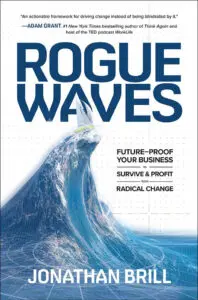We tend to think that what happens every decade, in fact, only happens every century, and, furthermore, that we know what’s going on.
—Nassim Taleb
When I started writing the book Future-Proof Your Business to Survive and Profit from Radical Change, I made a list of “moments in the future” that I had experienced that year. As I write these words, each of these trends has rippled from an oddity on the edge to a globally covered topic in the mass media. By the time you read this, they may be new ships riding in your sea lane. The point is, no matter how fast you think the future is moving, it’s moving faster.
During a visit to Beijing’s Tsinghua University in 2018, I made a casual joke to a Chinese colleague about drone technology. Sure, I said, autonomous drones are exciting, but when are we going to have one that can deliver a pizza?
At first, he looked confused. Then a flash of recognition crossed his face. He told me that JD.com had been using autonomous vehicles to deliver goods to students for over a year.
I assumed it was some graduate student hack or a way of cutting labor costs. But no, he assured me, they were developing this technology because the labor simply wasn’t available. In the world’s most populous country and second-largest economy, the demand for workers was so great that it was becoming impossible to fill once-common jobs like food delivery.
- At an energy company in India, an executive told me about their greatest challenge: the need to double their production capacity in the next few years. Never before in India’s history had demand for electricity grown so rapidly. The reason? Air-conditioning. The Indian middle class is growing at a breakneck pace. And in the sweltering cities of the subcontinent, the first thing a family buys when they can afford it—before a car, computer, or flat screen TV—is an air conditioner.
- In Wisconsin, an ailing industrial town was gearing up for the arrival of a Chinese company that had recently decided to relocate some of its manufacturing there. When I asked a Chinese executive what motivated the move, he explained that part of it was political and the need to put “Made in America” on its products. But the main reason was Wisconsin’s abundant supply of skilled labor, which is increasingly hard to find in Shenzhen.
- In a small village in southwestern China that only got electricity a few years ago, a functionally illiterate woman named Wei Fu sells her traditional weavings online, using artificial intelligence to link her goods to likely buyers around the world. She’s become so successful that she now runs a 25-woman cooperative.
Greater automation, the growing global middle class, and new technologies, such as artificial intelligence, are things we read about in articles. But they’re also things that happen to real people in unexpected and often far-flung places. Unfortunately, it’s very easy to ignore those macrotrends if we don’t see specific and tangible examples of their impact.

For executives and managers, this often leads to skepticism about the value of following them at all. Sure, they might say, it’s important to know what’s happening with the climate, advances in AI, or growing energy demand in South Asia, but we need to focus on what’s impacting the organization now, and what we can see happening in this quarter and the next.
A subset of the executives I talk with have a different take. The factors that will impact a business six months from now, they explain, are happening right now. As Jeff Bezos says, “earnings this quarter were baked three years ago.”
A macrotrend is the sum of thousands of individual events, and some of those events can spell opportunity for a company—or ruin. A more connected, faster–moving market means that a local change can have global impacts within a few weeks, not a few months. As the saying goes, “there are decades where nothing happens, and there are weeks when decades happen.” So any company dealing with an international market or supply chain, or that has vendors or clients who do—insert your organization here—should be paying attention to global macrotrends. The link between macro and micro is tighter than it’s ever been.
Knowing which macrotrends to focus on can be difficult, though. As with the mixing waters of the Agulhas, huge amounts of energy are exchanged invisibly by these trends and they don’t reveal themselves until they collide. As the world speeds up, those collisions become more frequent. This requires us to pay attention to the strongest macrotrends, even if they don’t seem immediately relevant. History doesn’t repeat itself, but it does rhyme. So while last year’s risk management techniques won’t protect you from next year’s challenges, they can provide insights into how they might evolve. Similarly, it can be useful to examine how major social, technological, and economic undercurrents in past eras have changed the system in which they operate.
Things move far, far faster today, but the 15th century provides a slow-motion snapshot of the sea change that these undercurrents can bring.
The West began to transition from the Middle Ages to the modern era in the 1400s, giving birth to the Renaissance and the Age of Exploration, the fall of great empires (the Byzantine, the Golden Horde) and the rise of new ones (the Spanish and Ottoman). The undercurrents that influenced these outcomes were powerful and diverse. The Black Plague of the mid-1300s killed a third of Europe’s population.
The result was that power and wealth landed in new hands as local economies imploded. New patterns of growth needed to be invented. Labor shortages drove up wages, while demand for goods went down. As agriculture became more challenging, many farmers and small landholders moved to cities in the hope of improving their fortunes. This drove political upheavals, as new cities like Florence and families like the Medicis rose to power. Subsequent technological breakthroughs helped offset the high cost of labor, increasing the efficiency of trade but also consolidating wealth for the cities and merchants who benefited. Foreign trade imbalances and a century of military conflict collided with currency shortages, caused by depleted silver and gold mines.
At the beginning of the 1400s, the economy of Europe was effectively bankrupt; by the end, some of its nations were fabulously wealthy. The growth of currency redefined the financial system, and a new globally connected civilization was beginning to coalesce.
There are echoes of those undercurrents in today’s world, except now the globe is literally wired, and change is happening at the speed of the Internet. The onset of COVID-19, for example, brought about 10 years’ worth of projected growth in online retail in the space of just three months.
Being able to spot the next rogue wave before your competitor does requires three things:
- Having at least a passing familiarity with today’s major undercurrents
- Paying special attention to events that cause two or more undercurrents to interact
- Building awareness of those trends throughout your organization, so that team members can scan the horizon for change
There are hundreds of such trends, of course, but maintaining awareness requires focusing on the undercurrents that are most likely to drive change when they intermix.
The former global futurist and research director at Hewlett Packard, Jonathan Brill is currently a board member and advisor to the chairman at Frost & Sullivan, a market intelligence firm that operates in 46 countries
Excerpted from Rogue Waves: Future-Proof Your Business to Survive and Profit from Radical Change by Jonathan Brill. Published by McGraw-Hill.
Recognize your brand’s excellence by applying to this year’s Brands That Matter Awards before the early-rate deadline, May 3.
